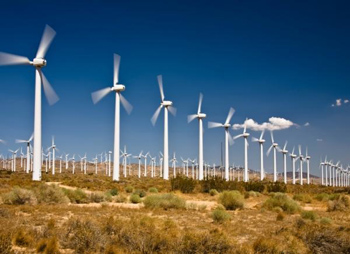Despite Uncertain Future, California Leads in Wind Power Installations
 BERKELEY, Calif. — Texas has been the leader in wind power installation for six years, but now California has taken the title. A new report by researchers at the Lawrence Berkeley National Laboratory in Berkeley, Calif., finds that California has led the country in installations in 2011, accounting for 921 megawatts of new wind power.
BERKELEY, Calif. — Texas has been the leader in wind power installation for six years, but now California has taken the title. A new report by researchers at the Lawrence Berkeley National Laboratory in Berkeley, Calif., finds that California has led the country in installations in 2011, accounting for 921 megawatts of new wind power.
The increase in wind power installations may be in large part due to the continued state and federal incentives for wind energy, recent improvements in the cost and performance of wind power technology, and the need to meet an end-of-year construction start deadline in order to qualify for the Section 1603 Treasury Grant Program, according to the report. The purpose of the Section 1603 payment is to reimburse eligible applicants for a portion of the cost of installing specified energy property used in a trade or business, or for the production of income, according to the U.S. Department of the Treasury.
With Section 1603 and other federal tax incentives for wind energy scheduled to expire at the end of 2012, new capacity additions in 2012 are anticipated to substantially exceed 2011 levels as developers rush to commission projects, the report states.
Although the numbers may be up currently, the future is uncertain, according to the report. The number of wind power installations are expected to decline by almost 56 percent in 2013, according to Vestas Wind Systems, the world’s largest wind turbine manufacturer.
With a drop in wind turbine orders, comes a drop in jobs for the companies supplying them. Vestas is expected to announce 1,600 job cuts, mostly in Colorado, once the federal tax incentives expire. Currently, President Obama is seeking to extend the tax credits, but some members in Congress are blocking his efforts and claim renewable industries don’t need government support, and they are in favor of ending all energy credits. The American Wind Energy Association has stated that a non-renewal could lead to the loss of almost 37,000 jobs.
This is not the first time that Congress has decided to expire renewable energy tax incentives. In 2003 Congress decided to expire the credits, and then in 2004 yearly wind installations dropped to just 397 megawatts, compared to 2003’s 1,670 megawatts.
Despite the uncertain future of wind power installations — the current boom has continued to change the industry. The growth in wind turbines can be measured by the number of installations, but also by the size of installations. Wind turbines continue to grow in size, as the average wind turbine in the U.S. is now a 1.97-megawatt turbine, compared to the 2010 average of 1.80 megawatts. The pole size has also increased from the 2010 average of 259-foot pole to the 2011 average of 265 feet, according to the report.
The wind power industry is constantly changing, but by the end of 2012 many companies will have a better grasp as to where they stand in the market.
